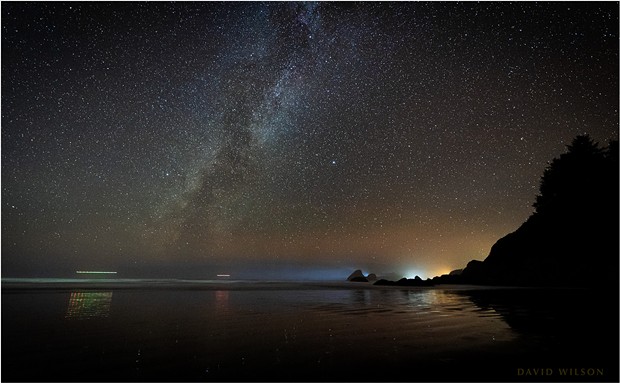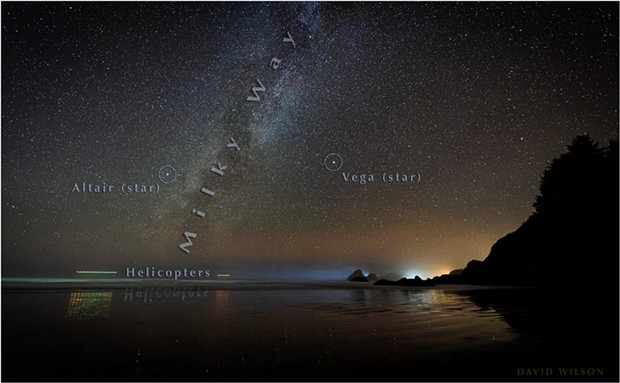Monday, December 2, 2019
North Coast Night Lights: Looking for a Monocerotid Unicorn
Posted By David Wilson on Mon, Dec 2, 2019 at 10:13 AM
The other week I was finally made aware of the existence of an elusive annual celestial phenomenon nicknamed the Unicorn meteor shower, or Alpha Monocerotids. So dubbed in part no doubt for its mercurial habits, the name is also eponymous for the constellation Monoceros, the Unicorn, from which the meteors appear to radiate. The constellation itself is faint and difficult to see, and the shifty meteor shower can vary widely in its intensity from one year to the next.
The Alpha Monocerotid shower occurs when Earth’s orbit takes it through the trail of debris left by an unknown comet at some point time in the past. It’s a narrow trail by cosmic standards, and we don’t always intersect with it perfectly as we ride our planet around the sun. This year Earth was predicted to hit the thick of it, but because the trail is so thin we would pass through it quickly and enjoy only a short window of possibly intense meteor action.
I’m not an astronomer, just an observer with an imagination. I imagine a comet’s trail of particles to be similar to a stream of water from a hose, except that it is fairly straight rather than bending down to the ground, and it’s not flowing because it was left behind by a comet rather than forced out of a hose. The debris trail is not absolutely straight, of course, as the comet is orbiting the sun, but still it is a path of particles that Earth passes through. Also, although water comes out of your hose in a solid column, the path of cometary particles is far less dense.
Now imagine passing a globe of Earth through the stream from your hose. As the stream of water splashes down onto the globe, so, too, does the stream of debris left by a comet. From the point of view of someone standing on Earth’s surface, this “stream” of particles will radiate from the point in the sky where the path is entering the atmosphere, which is called the radiant. What we see as meteors are the particles from the comet’s trail of flotsam burning up in our atmosphere. The radiant moves across the sky with the rest of the stars as the Earth revolves on its axis.
This year, the Monocerotid meteor shower was predicted to be fairly intense, but our part of the globe wasn’t predicted to see the best of the action. The radiant would be far out over the Atlantic during the shower, and the show would be over before it would rise here on the west coast of North America. The shower would begin around 8:15 p.m. for us and only last about an hour as Earth intersected the debris trail. The radiant, located in the constellation Monoceros beneath and a little to the north of Orion, wouldn’t rise in the east until around 9:30 p.m., after the shower’s peak. I knew we wouldn’t get a view of the radiant itself, but I had hopes that some outlying “earthgrazer” meteors would still be visible for us as they streaked a glancing arc through the atmosphere.
But in the end, my own tale of the meteor shower would reflect only the chase of a unicorn’s tail.
Additional reading:
The Unicorn, or Monoceros, is a “modern” constellation made in the 1600’s, not one of the Greek constellations: Read Ian Ridpath’s Star Tales for more information on it: http://www.ianridpath.com/startales/monoceros.htm
Sky and Telescope article on the Monocerotid meteor shower: https://www.skyandtelescope.com/astronomy-news/observing-news/intense-meteor-outburst-expected-alpha-monocerotids/
To keep abreast of David Wilson’s most current photography or peer into its past, visit or contact him at his website mindscapefx.com or follow him on Instagram at @david_wilson_mfx .
The Alpha Monocerotid shower occurs when Earth’s orbit takes it through the trail of debris left by an unknown comet at some point time in the past. It’s a narrow trail by cosmic standards, and we don’t always intersect with it perfectly as we ride our planet around the sun. This year Earth was predicted to hit the thick of it, but because the trail is so thin we would pass through it quickly and enjoy only a short window of possibly intense meteor action.
I’m not an astronomer, just an observer with an imagination. I imagine a comet’s trail of particles to be similar to a stream of water from a hose, except that it is fairly straight rather than bending down to the ground, and it’s not flowing because it was left behind by a comet rather than forced out of a hose. The debris trail is not absolutely straight, of course, as the comet is orbiting the sun, but still it is a path of particles that Earth passes through. Also, although water comes out of your hose in a solid column, the path of cometary particles is far less dense.
Now imagine passing a globe of Earth through the stream from your hose. As the stream of water splashes down onto the globe, so, too, does the stream of debris left by a comet. From the point of view of someone standing on Earth’s surface, this “stream” of particles will radiate from the point in the sky where the path is entering the atmosphere, which is called the radiant. What we see as meteors are the particles from the comet’s trail of flotsam burning up in our atmosphere. The radiant moves across the sky with the rest of the stars as the Earth revolves on its axis.
This year, the Monocerotid meteor shower was predicted to be fairly intense, but our part of the globe wasn’t predicted to see the best of the action. The radiant would be far out over the Atlantic during the shower, and the show would be over before it would rise here on the west coast of North America. The shower would begin around 8:15 p.m. for us and only last about an hour as Earth intersected the debris trail. The radiant, located in the constellation Monoceros beneath and a little to the north of Orion, wouldn’t rise in the east until around 9:30 p.m., after the shower’s peak. I knew we wouldn’t get a view of the radiant itself, but I had hopes that some outlying “earthgrazer” meteors would still be visible for us as they streaked a glancing arc through the atmosphere.
But in the end, my own tale of the meteor shower would reflect only the chase of a unicorn’s tail.
Additional reading:
The Unicorn, or Monoceros, is a “modern” constellation made in the 1600’s, not one of the Greek constellations: Read Ian Ridpath’s Star Tales for more information on it: http://www.ianridpath.com/startales/monoceros.htm
Sky and Telescope article on the Monocerotid meteor shower: https://www.skyandtelescope.com/astronomy-news/observing-news/intense-meteor-outburst-expected-alpha-monocerotids/
To keep abreast of David Wilson’s most current photography or peer into its past, visit or contact him at his website mindscapefx.com or follow him on Instagram at @david_wilson_mfx .






































